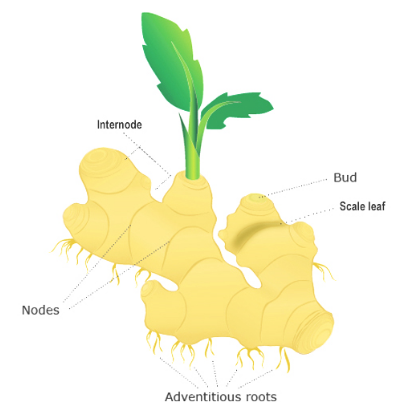
Ginger is a ______.
a) Rhizome
b) Tuber
c) Bulb
d) Corm
Answer
432k+ views
Hint: Since plants cannot move from one place to another in an unfavourable environment, they modify their body parts such as leaves, stems and roots to store nutrients and meet the unfavourable environmental conditions.
Complete answer:
Ginger is a modified stem. It has several nodes and internodes that give rise to leaves. As it bears all the nutrient content of the planet body so is consumed by humans as a crop. This modified stem pattern of Ginger is called Rhizome. They grow perpendicularly either on or under the ground. However, these plants have thread-like roots arising from the stem. Therefore, we can say that option A is the correct option.

Tuber is another form of modified stem. It also bears several nodes and internodes that later give rise to scaly leaves. These leaves have a bud that has potential to grow into a new plant individual. This type of stem is common to potatoes. As Ginger bears bidets but not buds so cannot be termed as Tuber. Therefore, option B is an incorrect option.
Bulb is another form of modified stem which is typically found in perennial monocotyledons. It is oval in shape and has underground buds. However, a small sized typical stalk is also present that bears flowers and leaves. Since, this kind of stem modification is not found in ginger therefore, it is an incorrect option.
Corm is also one of the patterns of stem modification. It is a combination of bulb and tuber which is short, vertical and swollen in structure. It is present underground. However, it has some green stalk body above the ground that bears flowers and leaves like tubers and is oval in structure and like a bulb. As this kind of stem modification is different from ginger thus, option D is also an incorrect option.
Note:
A plant body can be divided into three parts, that is, stem, leaves and roots. Stem and leaves are typically present above the ground and roots are present under the ground. Any one of these plant parts gets modified to store nutrients from a crop or vegetable. However, new branches arise from nodes or internodes (area between two nodes) on the stalk surface. In a ginger plant, scaly and non-green leaves arise from these nodes. It is an underground crop.
Complete answer:
Ginger is a modified stem. It has several nodes and internodes that give rise to leaves. As it bears all the nutrient content of the planet body so is consumed by humans as a crop. This modified stem pattern of Ginger is called Rhizome. They grow perpendicularly either on or under the ground. However, these plants have thread-like roots arising from the stem. Therefore, we can say that option A is the correct option.

Tuber is another form of modified stem. It also bears several nodes and internodes that later give rise to scaly leaves. These leaves have a bud that has potential to grow into a new plant individual. This type of stem is common to potatoes. As Ginger bears bidets but not buds so cannot be termed as Tuber. Therefore, option B is an incorrect option.
Bulb is another form of modified stem which is typically found in perennial monocotyledons. It is oval in shape and has underground buds. However, a small sized typical stalk is also present that bears flowers and leaves. Since, this kind of stem modification is not found in ginger therefore, it is an incorrect option.
Corm is also one of the patterns of stem modification. It is a combination of bulb and tuber which is short, vertical and swollen in structure. It is present underground. However, it has some green stalk body above the ground that bears flowers and leaves like tubers and is oval in structure and like a bulb. As this kind of stem modification is different from ginger thus, option D is also an incorrect option.
Note:
A plant body can be divided into three parts, that is, stem, leaves and roots. Stem and leaves are typically present above the ground and roots are present under the ground. Any one of these plant parts gets modified to store nutrients from a crop or vegetable. However, new branches arise from nodes or internodes (area between two nodes) on the stalk surface. In a ginger plant, scaly and non-green leaves arise from these nodes. It is an underground crop.
Recently Updated Pages
Master Class 9 General Knowledge: Engaging Questions & Answers for Success

Master Class 9 English: Engaging Questions & Answers for Success

Master Class 9 Science: Engaging Questions & Answers for Success

Master Class 9 Social Science: Engaging Questions & Answers for Success

Master Class 9 Maths: Engaging Questions & Answers for Success

Class 9 Question and Answer - Your Ultimate Solutions Guide

Trending doubts
State and prove Bernoullis theorem class 11 physics CBSE

What are Quantum numbers Explain the quantum number class 11 chemistry CBSE

Write the differences between monocot plants and dicot class 11 biology CBSE

Who built the Grand Trunk Road AChandragupta Maurya class 11 social science CBSE

1 ton equals to A 100 kg B 1000 kg C 10 kg D 10000 class 11 physics CBSE

State the laws of reflection of light




